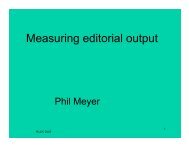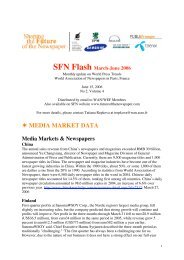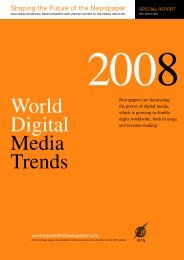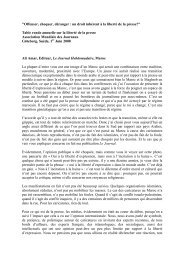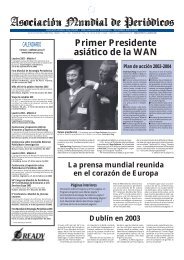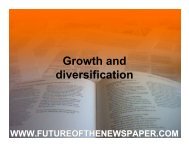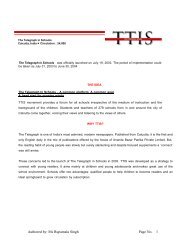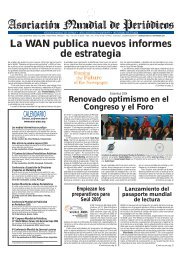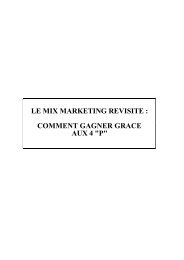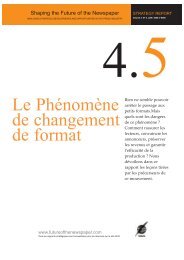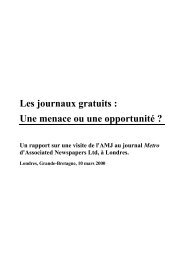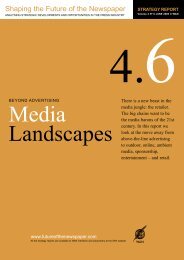WORLD PRESS TRENDS - World Association of Newspapers
WORLD PRESS TRENDS - World Association of Newspapers
WORLD PRESS TRENDS - World Association of Newspapers
Create successful ePaper yourself
Turn your PDF publications into a flip-book with our unique Google optimized e-Paper software.
SWEDEN<br />
Commentary - Swedish Newspaper Publishers <strong>Association</strong><br />
The Swedish economy continued to suffer during 2002. This<br />
was evident in newspaper advertising sales as well, which were<br />
down 7.2% for the whole year. During 2002, every quarter<br />
compared negatively to the corresponding quarter in 2001,<br />
although it recovered little by little throughout the year. There<br />
was no category that increased advertising sales, but the smaller<br />
the newspaper the less it decreased. Total advertising<br />
expenditure in traditional media (paid newspapers, magazines,<br />
TV, radio, cinema, and outdoor) decreased 5.7%. Advertising<br />
sales on the internet increased by 3.0%. Free sheets and outdoor<br />
also increased in 2002.<br />
Total circulation was 4,063,500 copies on weekdays. Comparable<br />
titles were up by 0.4% for 2002. Circulation for morning<br />
newspapers went down 0.2% while single copy tabloids were<br />
3.0%. 14 titles were published on Sundays in 2002. Sunday<br />
circulation fell by 0.6% for comparable titles.<br />
Readership is still strong in Sweden with 88% reading a daily<br />
newspaper (same as 2001).<br />
An increasing number <strong>of</strong> newspapers have a website with<br />
editorial content. 85% <strong>of</strong> dailies and 49% <strong>of</strong> non-dailies have a<br />
website with editorial content.<br />
One merger took place in 2002. Nordvästra Skånes Tidningar and<br />
Helsingborgs Dagblad in southern Sweden merged to become the<br />
largest newspaper outside Stockholm, Gothenburg and Malmo,<br />
and the 8th largest overall. The number <strong>of</strong> dailies decreased<br />
from 94 to 91 and the number <strong>of</strong> non-dailies decreased from 76<br />
to 75.<br />
The debate on whether to legislate on media concentration or<br />
not culminated in December 2001, when the Government<br />
withdrew its plans for a draft legislation, as it would be able to<br />
pass such a draft through the Parliament. The issue is, however,<br />
still on the Government’s agenda and in 2002 it asked The<br />
Competition Authority to make a report on media concentration<br />
in Sweden. This report should be completed before November<br />
2003.<br />
State subsidies are given to newspapers with a low household<br />
coverage in order to maintain plurality. The subsidies amounted<br />
to SKr 486 million in 2002, including a smaller subsidy <strong>of</strong> about<br />
SKr 75 million set aside for all daily newspapers which take<br />
part in a joint distribution system. Press subsidies and their effect<br />
on competition remain the subject <strong>of</strong> intense debate in political<br />
and newspaper industry circles.<br />
A new subsidy was introduced during 2002 for technical<br />
investment. The subsidy is <strong>of</strong> a total amount <strong>of</strong> SKr 45 million<br />
over a three-year period. It can only be received by newspaper<br />
companies that are subject to the general press subsidy system.<br />
Another new subsidy <strong>of</strong> SKr 15 million was introduced during<br />
2002, with the purpose <strong>of</strong> supporting the distribution <strong>of</strong><br />
newspaper copies with extreme costs. This subsidy is available<br />
when the distribution cost, on a weekly basis, exceeds a certain<br />
amount on average.<br />
For several years Sweden has had a special advertisement tax<br />
(4% for newspapers) on printed media. The tax has been<br />
criticised by the press and other media. There is a broad<br />
consensus that this tax should be abolished, but still the<br />
Government lacks alternative financing for the State budget to<br />
the tune <strong>of</strong> the U$100 million or so the advertising tax brings in.<br />
Nevertheless, the tax was partly abolished in 1998, but only on<br />
direct marketing – a step that made the distortion to competition<br />
even clearer. There is still also a debate on whether this tax –<br />
unusual in Europe – conforms to Community law. The industry<br />
has continued intense lobbying efforts during the year to abolish<br />
this tax.<br />
The convergence issue becomes more important and raises<br />
numerous legal questions when different sectors are being<br />
integrated. The Swedish newspaper industry is emphasising<br />
this issue and the consequences it might have from a legal point<br />
<strong>of</strong> view.<br />
When it comes to the question <strong>of</strong> copyright and employment,<br />
many newspaper companies faced difficulties in acquiring the<br />
rights they need to develop their businesses. The issue is to some<br />
extent solved in the collective agreement, but many practical<br />
problems occurred during the year.<br />
The problems in relation to freelancers and the debate on to<br />
which extent newspaper companies acquire copyright when<br />
buying material from freelancers remained intense.<br />
The discussion on how to apply traditional copyright law in<br />
the digital domain – and how to strike a balance between rights<br />
holders and the need for users – continued in the light <strong>of</strong> the<br />
discussions on how to implement the EU directive on copyright<br />
and neighbouring rights in the information society into domestic<br />
law. The announced draft for this implementation was delayed<br />
during 2002 and is now expected to be presented during spring<br />
2003.<br />
POPULATION<br />
Population by age and sex<br />
All individuals Male Female Households<br />
000 % 000 % 000 % 000<br />
0-15 1,724 19 884 20 840 19 4,363<br />
16-24 937 10 479 11 458 10<br />
25-34 1,180 13 601 14 580 13<br />
35-44 1,251 14 640 14 611 14<br />
45-54 1,195 13 604 14 591 13<br />
55-64 1,119 13 563 13 556 12<br />
65+ 1,534 17 656 15 878 19<br />
Total 8,941 100 4,427 100 4,514 100<br />
Source: SCB<br />
Age structure <strong>of</strong> daily readership<br />
% <strong>of</strong> % reach within<br />
Age readership age group<br />
15-24 13.6 79.3<br />
25-34 16.3 82.0<br />
35-44 18.1 88.2<br />
45-54 18.5 92.0<br />
55-64 16.9 94.4<br />
65-79 16.6 93.5<br />
Source: Orvesto Konsument 2002, Research<br />
International<br />
<strong>WORLD</strong> ASSOCIATION OF NEWSPAPERS - <strong>WORLD</strong> <strong>PRESS</strong> <strong>TRENDS</strong> 2003 259




